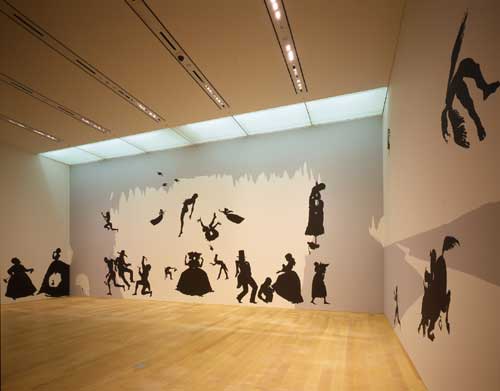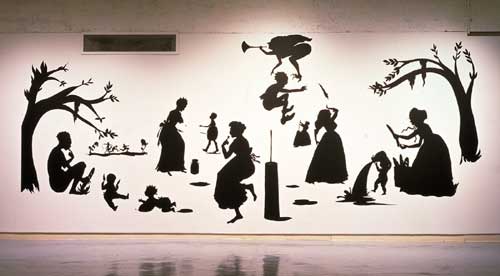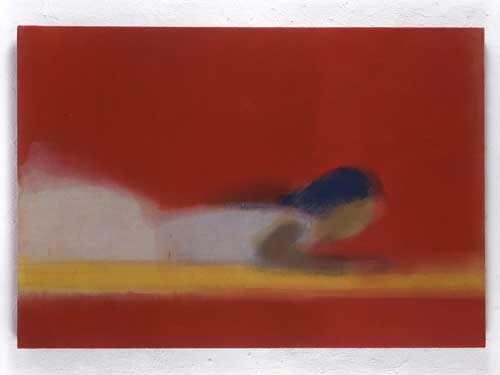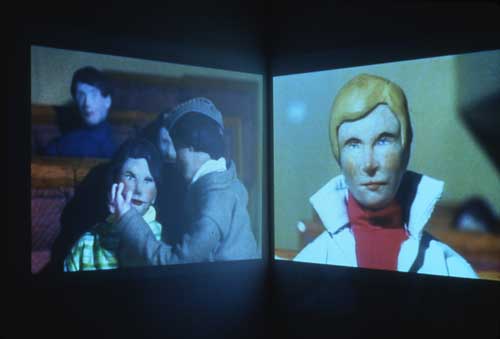

Mori Art Museum, Tokyo
29 March - 19 June 2005
Curator of the exhibition, Araki Natsumi, explains that she conceived the exhibition as a book, in which the artists each tell their story in chapters. In many cases, the stories are obscure and visitors are encouraged to make up their own. Natsumi hopes that the show can help to change the public's opinion of contemporary art - which, she believes, is often considered to be incomprehensible - and to make the viewers feel that there is a connection between their own lives and those of contemporary artists.
Natsumi is right to feel optimistic about her objective, as the works she has selected convey messages in a narrative style that will, most likely, be accessible to viewers. Narrative as the most ancient technique of storytelling is also widely used by many contemporary artists in their works. But the narrative themes used in contemporary art differ greatly from conventional ones. In ancient Greek and Roman art, and pre-20th century religious artwork, narratives typically focused on the lives of the elite and their societies, or around their myths or religions. Contemporary narratives explored in this exhibition focus on the experiences of ordinary people. They are about 'all sorts of physical and psychological experiences that are part of human life, including intense emotion, desire, absurdity, taboo and humour'.2
Family life, for example, is a subject to which most people can relate and has great emotional relevance. We all hope for a harmonious family in which each member is happy and fulfilled, and this hope often results in a tendency to idealise our family situations and obscure the problems that inevitably arise in relationships. A number of works in the show aim to reveal the conflicts between family members and to show how difficult, or impossible, it is for human beings to behave in a rational way in such emotional contexts. Some examples are Finnish artist Eija-Liisa Ahtila's 'Me/We, Okay, Gray', a three-channel video installation and 'Consolation Service', a two-channel DVD installation; Swedish artist Annee Olofsson's 'Unfamiliar' series of type C prints and Iraqi artist Jananne Al-Ani's 'A Loving Man', a five-channel video installation.
American Artist Karen Yasinsky and Japanese artists Leiko Ikemura and Motohiko Odani use forms of human beings and animals to tell stories. In Yasinsky's 'Fear', a two-channel video installation, clay dolls with hairstyles and clothing from the 1950s and 1960s are shown as passengers in a plane; among them are a woman and man who occasionally shed tears. Although the dolls' facial expressions remain unchanged, the tears that roll down their cheeks may deeply touch viewers and remind them of the fear of separation and loneliness that all human beings experience at one time or another in their lives. Similarly, when viewers look at the girls with blank faces in Ikemura's paintings and sculpture, they will feel a connection to their own memories of being hurt and feeling helpless.
Odani's black and white two-channel DVD installation, 'Jackal', shows a diorama of a house on the left, and a dog walking in circles inside the house next to it, on the right. The dog's intestines dangle down and its muscle tissues are visible. Both the changing weather outside the house and the fast-spinning hands of a clock on the wall inside the house in which the dog walks indicate the passing of time, but the dog continues to walk aimlessly in circles, occasionally eating its own droppings. This provocative scene forces viewers to reflect on the creature's life, devoid of hope, desire or fantasy.
Some of the artists represented in the show reveal social or political issues in their works. South African artist, William Kentridge's DVD animation, made from charcoal drawings, entitled 'Tide Table', is one example. Even if the artist denied his intention to 'incorporate political value judgements into his work',3 one can easily sense the issue of race being examined in the story, which is conveyed by fast-changing images of startling characters: slaughtered cattle; ill and dying black people in an overcrowded hospital and a white businessman wearing a suit, who peers out from a hotel balcony through his binoculars and reads a newspaper in his chair at the beach. Similarly, when viewers stand in front of American artist Kara Walker's politically charged silhouetted paper cut-out, 'The Long Hot Black Road to Freedom, a Double-Dixie Two-Step', which was glued on to three walls in the gallery, they may find themselves relating the images to well-known stories of how black slaves fought for their freedom in the American Civil War.
Taking advantage of the more flexible means provided by modern technology, contemporary artists also challenge traditional ways of reading narratives. In this exhibition, Irish artist Teresa Hubbard and Swiss artist Alexander Birchler's 'Single Wide' (high-definition video) diminish the beginning and the end-points in telling their story. The camera moves around to film a trailer home from the inside and outside. The moving image is a frustrated woman sitting in a pick-up truck who suddenly rams the truck into the trailer. She gets out of the truck, goes into the trailer to examine her wound in front of a mirror, and goes out again to sit in the truck. Depending on the point at which each viewer begins to look at the video, he or she will develop a different narrative.
German artist Stefan Exler and British artist Mark Wallinger seem to be very successful at playing tricks on our minds. Exler's 'Untitled' series of photographs portray scenes of rooms that are so chaotic that one doesn't know where to start to tell the story. He achieved this disturbing visual effect by shooting the photos directly from above, without leaving a shadow on any single item. It is not possible to focus on any one object and the result is that viewers may feel helpless in their pursuit of meaning, or narrative.
Looking at the slow motion scenes of people walking out of an arrival gate at an international airport in the UK, in Wallinger's video, 'Threshold to the Kingdom', and listening to the solemn church music playing in the background, viewers will have to wait for some dramatic events to happen. But, after 11 minutes and 10 seconds, they will realise that they have been fooled by the association of 'church music with the sublime, and slow motion with decisive moments.'4
Also in the exhibition are works by American artist Gregory Crewdson, Japanese artist Tomoko Konoike and Australian artist Tracy Moffatt. The show runs until 19 June 2005.
Cao Yin
References
1. Elliott D. Foreword. In: The World is a Stage: Stories Behind Pictures, Tokyo: Mori Art Museum, 2005.
2. Natsumi A. Narratives Spun by Art. In: Ibid: 154.
3. Natsumi A. Ibid: 162.
4. Natsumi A. Ibid: 158.



